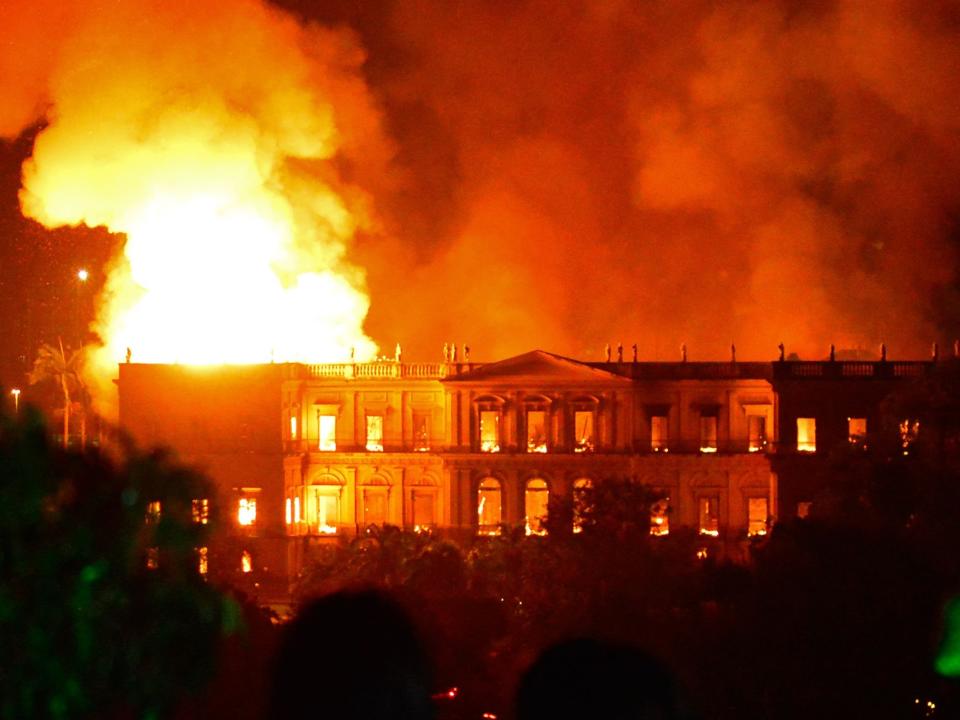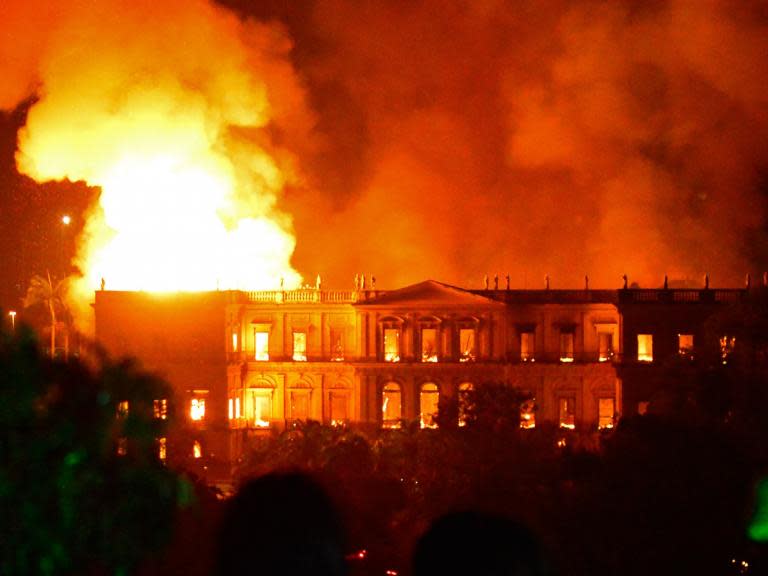Rio fire: Towering inferno consumes Brazil's national museum full of 200 years of priceless relics
A huge fire has broken out at the 200-year-old National Museum of Brazil in Rio de Janeiro, engulfing the entire structure and leaving workers scrambling to rescue its priceless relics.
The inferno could be seen for many miles around as the historic building, formerly the palace of the Portuguese royal family, was consumed by flames.
Brazil’s president, Michel Temer, called it “a sad day for all Brazilians”.
“Two hundred years of work, investigation and knowledge have been lost,” Mr Temer said in a statement. “The value of our history cannot be measured by the damage to the building.”
The fire broke out at around 7.30pm on Sunday night, when the museum was closed to visitors. A museum spokesperson said no injuries were reported, and it was not clear how the fire started.
Three security guards, who had been inside the building at the time the blaze began, were reportedly able to escape the flames unharmed.
Roberto Robadey, a spokesperson for the fire department, said 80 firefighters were battling the blaze and that by midnight local time it was “just about under control”. Several hotspots remained inside the ruins as dawn broke on Monday.
The museum housed artefacts from Egypt, Greco-Roman art and, in its natural history collection, significant dinosaur bone discoveries and the 12,000-year-old skeleton of a woman – the oldest human ever found in the Americas.
But employees have previously complained of the dilapidated state of the building due to underfunding.
Firefighters complained they were hampered in their efforts to tackle the blaze on Sunday night because the two fire hydrants closest to the museum were not functioning. Instead, trucks had to be sent to get water from a nearby lake.
Nonetheless, some of the museum’s pieces have been saved.
“We were able to remove a lot of things from inside with the help of workers of the museum,” the firefighters’ spokesperson Robadey told Globo News.
However, the Roberto Marinho Foundation, a charity which promotes educational opportunities in Brazil, said it “deeply regrets” what it described as the “immeasurable destruction” of the museum’s collection.
“We are devastated by this tragedy, which has consumed a gigantic part of our history, and results in an irreparable loss today and for future generations,” the organisation added in a statement.
Connected to the Federal University of Rio de Janeiro, the museum has expositions that include anthropology, archaeology and palaeontology, among others.
The vice-director of the museum, Luiz Fernando Dias Duarte, also picked up the issue of funding cuts. He told Globo news: “Everybody wants to be supportive now. We never had adequate support.”
Latin America’s largest nation has struggled to emerge from its worst recession in decades. The state of Rio de Janeiro has been particularly hard hit in recent years thanks to a combination of falling world prices of oil, one of its major revenue sources, mismanagement and massive corruption.
Just over a month before national elections, even before the flames were put out, the fire was leading to recriminations about dilapidated infrastructure and budget deficits in the city that hosted the 2016 Olympics.
“Unfortunately, given the financial straits of the Federal University of Rio de Janeiro and all the other public universities the last three years, this was a tragedy that could be seen coming,” Marina Silva, one of the leading presidential candidates, tweeted.
On Instagram, Rio mayor Marcelo Crivella called on the country to rebuild.
“It’s a national obligation to reconstruct it from the ashes, recompose every eternal detail of the paintings and photos. Even if they are not original, they continue to be a reminder of the royal family that gave us independence, the (Portuguese) empire and the first constitution and national unity,” he said.
The museum is housed inside the Paco de Sao Cristovao, a neoclassical palace set in the Quinta da Boa Vista park.
The building had previously served as a residence of the Portuguese royal family and later Brazil’s imperial family.
Additional reporting by AP


